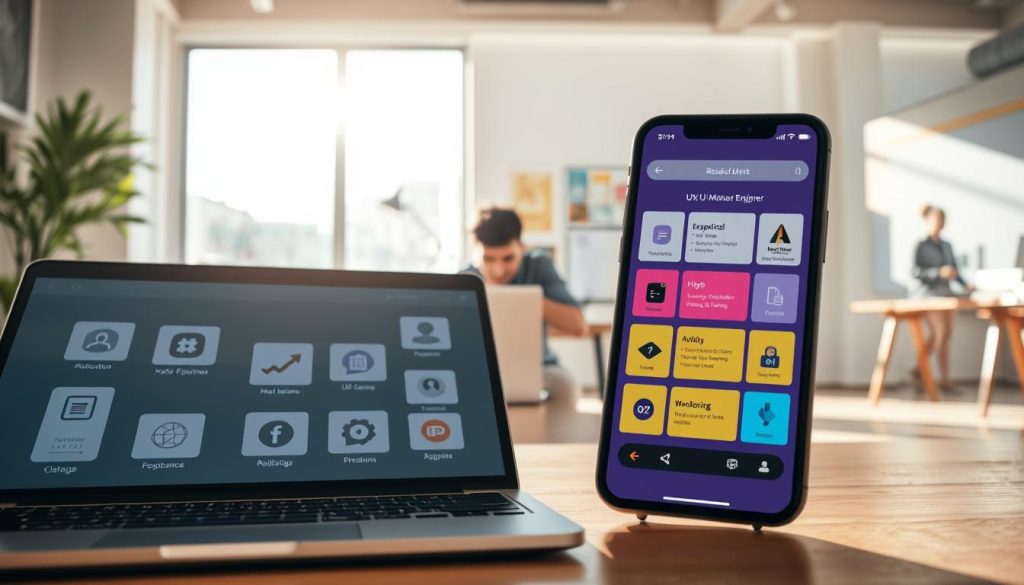Finding the right creative partner for your digital projects can transform your business. A skilled freelance UX/UI designer brings specialized expertise to create exceptional user experiences.
These professionals focus on making digital products intuitive and engaging. They understand how users interact with websites and applications.
Today’s competitive market demands professional design services. Businesses need visually appealing platforms that also function perfectly.
Working with independent experts offers flexibility and focused attention. You get dedicated support without agency overhead costs.
This guide will help you navigate the hiring process successfully. We’ll show you how to find the perfect match for your specific needs.
Table of Contents
Key Takeaways
- Freelance designers offer specialized expertise for digital projects
- User-centered design creates more successful products
- Independent professionals provide flexible, cost-effective solutions
- Quality design improves user engagement and satisfaction
- This guide helps you find the right design partner
- Good design considers both visual appeal and functionality
- The right designer understands your specific business needs
Understanding UX/UI Design and Its Importance
The foundation of successful digital products lies in mastering two complementary design disciplines. These approaches work together to create experiences that users love and businesses value.
Great digital design balances aesthetic appeal with practical functionality. It considers how people interact with technology in their daily lives.
What Exactly is UX vs UI Design?
User Experience design focuses on how people feel when using a product. It enhances satisfaction by improving usability, accessibility, and pleasure during interaction.
User Interface design creates the visual elements users see and touch. This includes buttons, icons, spacing, and color schemes that make up digital interfaces.
While these disciplines differ, they work together harmoniously. UX considers the overall journey, while UI handles the visual presentation.
Why User-Centered Design Matters for Your Business
The user-centered approach puts actual user needs at the forefront of development. This method solves real problems rather than working from assumptions.
Julien’s work with EDF R&D demonstrates this value perfectly. His quick understanding of business challenges and user navigation recommendations transformed their scientific computing interface.
Proper design leads to higher engagement and conversion rates. Customers stay longer on well-designed site platforms and application mobile experiences.
Businesses see reduced development costs and increased ROI. Good design identifies issues early, saving time and resources throughout the project lifecycle.
Poor design negatively impacts user retention and business outcomes. Frustrating experiences drive customers away to competitors with better solutions.
Understanding both user needs and business objectives creates successful products. This balanced approach delivers value to everyone involved in the digital experience.
Benefits of Hiring a Freelance UX/UI Designer
Choosing the right creative professional brings numerous advantages to your digital initiatives. Independent specialists offer unique value that can significantly enhance your project outcomes.

These experts work across various sectors including mobile applications, SaaS platforms, and business software. Their diverse background provides valuable insights for startups and established corporations alike.
Flexibility and Specialized Expertise
Independent professionals adapt to your specific needs and timelines. They offer engagement models ranging from single projects to ongoing support arrangements.
Their broad experience across different industries brings fresh perspectives to your challenges. This variety enhances problem-solving and innovation in your digital products.
You gain access to specialized skills without long-term commitments. This flexibility allows businesses to scale resources based on current project demands.
Cost-Effectiveness for Projects of All Sizes
Hiring independent talent eliminates many overhead costs associated with full-time staff. You pay for expertise only when needed, optimizing your budget allocation.
Businesses avoid expenses like benefits, office space, and equipment. This financial efficiency makes top-tier design accessible to organizations of any size.
The quality of work often exceeds expectations due to focused attention. Specialists dedicated to your project deliver exceptional results that drive business growth.
Many companies report significant savings while achieving better outcomes. The right partnership transforms how you approach digital product development.
Key Skills to Look for in a Freelance UX/UI Designer
Identifying the right creative talent requires understanding what makes exceptional digital experiences. The best professionals combine technical mastery with deep human understanding.
Great digital creators possess a unique blend of artistic vision and analytical thinking. They translate complex requirements into intuitive, beautiful solutions.
User Research and Discovery Capabilities
Top professionals excel at uncovering real user needs through various research methods. They conduct interviews, surveys, and usability tests to gather valuable insights.
Discovery practices help understand pain points and business context thoroughly. This compréhension of user behavior informs every design decision.
Effective research includes data analysis and synthesis skills. Professionals formalize methodology standards to ensure consistent, reliable results.
Technical Proficiency with Design Tools
Mastery of industry-standard software demonstrates professional capability. Experts work efficiently with Figma, Sketch, Adobe XD, and prototyping tools.
Toolstack management ensures smooth workflow and collaboration. The right outils enable high-quality production and efficient project gestion.
Staying updated with emerging technologies shows commitment to growth. This adaptability keeps solutions relevant and innovative.
Business Understanding and Strategic Thinking
The best creators align design decisions with business objectives seamlessly. They understand how digital experiences impact overall success.
Strategic thinking balances creative vision with practical constraints. This approach ensures solutions meet both user besoins and business goals.
Strong métier knowledge helps create solutions that drive real value. Professionals who understand business context deliver more effective results.
| Skill Category | Key Competencies | Business Impact |
|---|---|---|
| Research & Discovery | User interviews, data analysis, usability testing | Reduces development costs, improves user satisfaction |
| Technical Execution | Figma/Sketch mastery, prototyping, tool management | Increases production quality, ensures project consistency |
| Business Strategy | Objective alignment, metric tracking, ROI analysis | Enhances conversion rates, supports business growth |
| Communication | Presentation skills, stakeholder management, rationale articulation | Improves team collaboration, ensures clear understanding |
Information architecture skills create intuitive navigation and organization. Interaction design principles guide users through digital experiences smoothly.
Visual design expertise includes typography, color theory, and layout principles. These elements work together to create aesthetically pleasing interfaces.
Communication abilities are crucial for presenting design rationale effectively. As highlighted in marketing resources for independent professionals, 78% of clients prioritize analytical competencies that help understand user behavior.
Continuous learning frameworks keep professionals updated with industry trends. This commitment to growth ensures fresh, innovative approaches to each mission.
Impact measurement skills demonstrate the value of design decisions quantitatively. Professionals who track results provide clearer insights into project success.
The ideal candidate balances creative flair with practical problem-solving abilities. This combination delivers exceptional digital experiences that users love and businesses value.
Evaluating a Designer’s Portfolio and Past Work
A designer’s portfolio tells the story of their skills and approach. Look beyond pretty pictures to understand their problem-solving abilities.
Great portfolios show how thinking translates into successful digital products. They demonstrate real-world impact on businesses and users.

Quality work reveals attention to detail and user needs. The best examples include context about challenges and solutions.
Assessing Mobile App and Web Design Projects
Mobile applications require special attention to touch interactions and screen sizes. Look for intuitive navigation patterns that feel natural.
Check how designs adapt across different devices. Responsive layouts should maintain functionality and aesthetic appeal.
Examine user flow efficiency in application mobile projects. Smooth parcours keeps users engaged and reduces frustration.
For web projects, evaluate loading speed and information architecture. Good site design makes content easy to find and understand.
Look for evidence of accessibility considerations. Proper color contrast and text sizes help all users.
Looking for Evidence of User-Centered Solutions
The best portfolios show research behind design decisions. Case studies should explain why certain solutions were chosen.
Look for before-and-after examples that demonstrate improvement. Refonte projects often show measurable results.
Check how designers handle complex interfaces for business software. Clean organization makes complicated tasks manageable.
Examine documentation quality in portfolio presentations. Good case studies include:
- Clear problem statements and business objectives
- Research methods and user insights
- Design iterations and rationale
- Final solutions and measurable outcomes
Diverse project experience across industries shows adaptability. Different clients and user demographics test versatility.
| Portfolio Element | What to Look For | Red Flags to Avoid |
|---|---|---|
| Mobile Applications | Intuitive navigation, responsive design, smooth user flow | Poor performance, confusing menus, inconsistent patterns |
| Web Projects | Fast loading, clear information architecture, accessibility | Cluttered layouts, poor mobile adaptation, slow performance |
| Case Studies | Problem context, research data, solution rationale, results | Missing context, no metrics, superficial explanations |
| Project Diversity | Multiple industries, various user types, different challenges | Limited scope, similar projects, narrow focus |
| Visual Quality | Consistent charte graphique, attention to detail, brand alignment | Inconsistent styling, poor typography, weak visual hierarchy |
Evaluate business impact shown in past travail. Look for metrics like conversion improvements or user engagement increases.
Check how designers handle complete project lifecycles. The best expériences include research, design, testing, and implementation.
Assess problem-solving approach in each projet. Creative solutions should address real user needs effectively.
Look for evidence of collaboration with development teams. Smooth handoff processes ensure design integrity in final création.
Platform expertise matters for specialized application needs. Experience with specific technologies can be valuable.
Finally, trust your instincts about communication style and cultural fit. The right partner understands your vision and business context.
Understanding the UX/UI Design Process
Great digital products don’t happen by accident. They follow a structured approach that balances creativity with methodical thinking. This process ensures every decision serves both user needs and business goals.
The journey from idea to finished product involves multiple phases. Each stage builds upon the previous one, creating a solid foundation for success. This systematic approach reduces risks and maximizes your project’s potential.
From Discovery to Delivery: The Complete Workflow
The discovery phase kicks off every successful project. Teams conduct user research and competitive analysis during this critical stage. They gather business requirements to understand the full context.
User segmentation helps identify different audience groups and their unique needs. Continuous research frameworks ensure learning never stops throughout the project. This ongoing discovery process keeps solutions aligned with real user requirements.
Ideation transforms research insights into concrete solutions. Professionals create wireframes, mockups, and interactive prototypes during this phase. These visual representations help stakeholders understand the proposed direction.
Testing validates design decisions before full development begins. Usability testing identifies potential issues early, saving time and resources. Feedback incorporation refines solutions until they meet user expectations perfectly.
The handoff process ensures smooth transition to development teams. Design specifications and asset preparation make implementation straightforward. This careful coordination maintains design integrity throughout production.
Post-launch activities complete the cycle beautifully. Teams review analytics and collect user feedback after release. Iterative improvements keep the product evolving based on real usage data.
How Design Thinking Workshops Add Value
Design thinking workshops bring stakeholders and users together creatively. These collaborative sessions uncover deep insights about user intentions and pain points. They transform abstract concepts into practical solutions.
Workshops build apps based on actual user barriers and motivations. Participants explore different perspectives through structured activities. This shared understanding creates stronger alignment across the entire team.
The collaborative nature of these sessions generates innovative ideas. Diverse viewpoints lead to more comprehensive solutions. Everyone contributes to shaping the final product experience.
These workshops reduce development risks significantly. They validate assumptions before committing resources to building features. This proactive approach ensures better product-market fit from the start.
| Process Phase | Key Activities | Expected Outcomes |
|---|---|---|
| Discovery & Research | User interviews, competitive analysis, requirement gathering | Clear project scope, user insights, business alignment |
| Ideation & Prototyping | Wireframing, mockups, interactive prototypes | Visual direction, stakeholder alignment, concept validation |
| Testing & Iteration | Usability testing, feedback collection, design refinement | Improved usability, risk reduction, user validation |
| Handoff & Development | Specification documents, asset preparation, team coordination | Smooth implementation, design consistency, quality assurance |
| Post-Launch & Evolution | Analytics review, feedback collection, iterative improvements | Continuous enhancement, performance tracking, user satisfaction |
Proper process management ensures consistent quality throughout your project. It creates digital experiences that users love and businesses value. This structured approach delivers measurable impact for your organization.
Continuous discovery practices maintain relevance over time. They adapt to changing user needs and market conditions. This ongoing learning mindset keeps digital products competitive and effective.
The right process balances creativity with practical constraints. It delivers beautiful solutions that also work perfectly in the real world. This combination creates lasting value for users and businesses alike.
Collaboration and Communication Approach
Successful digital projects thrive on strong teamwork and clear dialogue. The right partnership approach makes all the difference in achieving outstanding results.
Effective collaboration ensures everyone moves in the same direction. It transforms individual efforts into cohesive, powerful outcomes.

Working with Your Team and Stakeholders
Regular updates keep everyone informed and engaged throughout the project lifecycle. Clear communication prevents misunderstandings and keeps work on track.
Professionals adapt quickly to existing company cultures and workflows. They become temporary team members who understand your unique environment.
Stakeholder management requires keeping all parties informed and involved. Good partners provide just the right amount of information at the right time.
Julien’s work with EDF R&D shows the power of responsive communication. His quick understanding of their scientific computing needs led to excellent results.
This approach demonstrates how proper dialogue enhances project outcomes. It builds trust and ensures alignment across all team members.
Tools and Methods for Effective Collaboration
Modern teams use various platforms to work together efficiently. These tools bridge geographical distances and time zone challenges.
Figma enables real-time design collaboration with instant feedback capabilities. Teams can work simultaneously on the same interface designs.
Project management tools like Trello and Asana track progress clearly. They help manage milestones and keep everyone aware of deadlines.
Communication platforms including Slack and Microsoft Teams facilitate daily interactions. They create spaces for quick questions and updates.
Research tools like Dovetail organize user insights systematically. Confluence serves as a knowledge base for project documentation.
Shared templates and GPT assistants streamline research operations. They maintain consistency across different project phases.
Establishing clear communication protocols prevents confusion. Regular meeting rhythms ensure consistent progress updates.
Remote collaboration requires special attention to cultural considerations. Understanding different work styles improves team dynamics.
Time zone management respects everyone’s working hours and availability. It creates a balanced approach to international projects.
The right tool combination supports smooth project execution. It enhances both the process quality and final outcomes.
Pricing Models and Budget Considerations
Smart budget planning ensures your project delivers maximum value without financial surprises. Understanding different pricing approaches helps you make informed decisions that balance quality and cost.
Every project deserves a pricing strategy that matches its unique requirements. The right approach considers both immediate needs and long-term goals.
Common Freelance Pricing Structures
Independent professionals typically offer three main pricing models. Each option serves different project types and client preferences.
Hourly rates work well for ongoing support or uncertain scope projects. You pay only for actual time spent on your mission.
Project-based pricing provides fixed costs for well-defined initiatives. This approach offers budget certainty for specific deliverables.
Retainer agreements create ongoing partnerships for continuous work. They ensure availability for regular design needs and updates.
Several factors influence final pricing decisions. Experience level significantly impacts rates, with seasoned professionals commanding higher fees.
Specialization areas may affect costs for niche expertise. Complex projects requiring specific compétences often justify premium pricing.
Project complexity directly relates to required effort and resources. Tight deadlines or unusual requirements may increase overall costs.
| Experience Level | Hourly Rate Range (€) | Project Range (€) | Typical Background |
|---|---|---|---|
| Junior (0-2 ans) | 25-45 | 1,000-3,500 | Recent graduates, limited portfolio |
| Mid-Level (3-5 ans) | 45-75 | 3,500-8,000 | Multiple completed projects, broader skills |
| Senior (5+ ans) | 75-120+ | 8,000-20,000+ | Proven track record, strategic thinking |
Balancing Quality with Project Budget
Value assessment goes beyond comparing price tags alone. Consider the long-term impact on your entreprise when evaluating options.
Quality design work delivers better user experiences and business outcomes. Investing in proper conception saves money through reduced revisions and improved results.
Payment structures should protect both parties throughout the collaboration. Common approaches include:
- Initial deposit to secure the engagement
- Milestone payments tied to specific deliverables
- Final payment upon satisfactory completion
Clear quotes prevent misunderstandings about scope and costs. They should specify included revisions, support periods, and any potential additional expenses.
Negotiation should focus on fair value rather than lowest price. Both clients and professionals deserve reasonable compensation for their contributions.
Choosing based solely on price often leads to hidden costs later. These may include rework, project delays, or unsatisfactory user experiences.
Budget flexibility accommodates unexpected changes or additional feature requests. Building contingency into your plan ensures smooth project gestion.
The right pricing approach supports successful production while meeting business besoins. It creates partnerships where everyone feels valued and motivated.
Finding the Right Freelance UX/UI Designer for Your Project
Locating the perfect creative partner requires knowing where to look and what to ask. The search process combines platform exploration with careful evaluation.
Successful matches happen when both skills and personality align with your needs. This careful approach ensures a productive partnership from day one.

Where to Search for Qualified French Designers
Several specialized platforms connect businesses with talented professionals in France. These networks streamline the discovery and hiring process effectively.
Malt stands out as a popular choice for finding vetted independent experts. It offers detailed profiles and verified client reviews for informed decisions.
Comet provides another excellent option focusing on creative and digital talent. Its community features help assess cultural fit before initial contact.
LinkedIn remains a powerful tool for discovering professionals through networks. Its search filters help narrow candidates by skills and experience.
Design communities like Behance and Dribbble showcase actual work quality. These platforms display creative abilities beyond standard resumes.
Personal websites often reveal the most about a professional’s approach. They demonstrate communication style and project presentation skills.
Referrals from trusted business contacts provide valuable insights too. First-hand recommendations reduce uncertainty about working relationships.
Industry events and meetups offer opportunities for informal meetings. These connections sometimes lead to the most successful collaborations.
Interview Questions to Ask Potential Candidates
The right questions reveal both technical abilities and problem-solving approaches. They help assess whether someone fits your specific project needs.
Start by exploring their understanding of your business challenges. Ask how they would approach your particular user experience goals.
Inquire about their process for researching user needs and behaviors. Understanding their methods shows how they gather crucial insights.
Discuss their experience with similar projects or industries. This reveals relevant background that could benefit your initiative.
Ask about their preferred collaboration tools and communication style. This indicates how well they’ll integrate with your existing team.
Request specific examples of challenging projects and their solutions. These stories demonstrate practical problem-solving abilities.
Explore their familiarity with your type of platform or technology. Technical alignment ensures smoother implementation later.
Inquire about availability and typical response times for urgent matters. This helps set realistic expectations about workflow.
Ask for references from past clients with similar project types. Follow-up conversations provide valuable third-party perspectives.
Consider including a practical test or case study review. This reveals how they think through real design challenges.
| Evaluation Area | Key Questions to Ask | What Their Answers Reveal |
|---|---|---|
| Technical Skills | « Which tools do you use for prototyping and collaboration? » | Tool proficiency and workflow efficiency |
| Process Understanding | « How do you approach user research for new projects? » | Methodological rigor and user focus |
| Problem-Solving | « Can you walk me through a challenging design problem you solved? » | Creative thinking and practical execution |
| Cultural Fit | « How do you prefer to communicate with clients and teams? » | Collaboration style and adaptability |
| Industry Experience | « What similar projects have you completed in our sector? » | Relevant background and domain knowledge |
| Availability | « What is your typical turnaround time for feedback and revisions? » | Responsiveness and project commitment |
Checking references completes the evaluation process thoroughly. Past client testimonials provide authentic insights about working relationships.
Review their ability to meet specific timelines and deliverables. This ensures they can handle your project’s schedule demands.
Assess their understanding of your users’ journey and needs. The right partner grasps both business objectives and user requirements.
Practical design tests reveal hands-on abilities beyond portfolio presentations. They show how candidates approach real-world challenges.
Case study discussions demonstrate depth of thinking and rationale behind decisions. They reveal strategic approach beyond visual execution.
The selection process balances skills assessment with personality evaluation. Both elements contribute equally to successful partnerships.
Remember that the best fit combines talent with collaborative spirit. This combination delivers exceptional results for your digital initiative.
Making the Final Decision and Starting Your Project
Once you’ve selected your ideal creative partner, proper setup ensures smooth sailing. The transition from selection to active collaboration requires careful planning and clear agreements.
This phase transforms your choice into productive partnership. It establishes the foundation for successful project execution and outstanding results.
Contract Considerations and Project Kickoff
A solid agreement protects both parties and clarifies expectations. It transforms verbal understandings into documented commitments.
Key contract elements include scope of services with specific tasks and milestones. Deliverables should list each item with firm dates where possible.
Payment terms outline fixed fees, hourly rates, or milestone-based compensation. Many professionals request deposits to secure engagement dates.
Confidentiality clauses protect sensitive business information. They define duration periods and return obligations for project materials.
Intellectual property considerations ensure proper ownership transfer. Design work typically transfers to clients after full payment completion.
Background intellectual property remains the contractor’s property. It receives licensing for product use within the project scope.
The kickoff process begins with initial alignment meetings. Teams discuss project goals, timelines, and communication preferences.
Tool setup and access provisioning happen during this phase. Everyone receives necessary software access and system permissions.
Using comprehensive freelance agreement templates ensures nothing gets overlooked. These documents provide professional frameworks for successful collaborations.
Setting Clear Expectations and Deliverables
Establishing measurable success criteria keeps projects focused. These indicators help evaluate progress and final outcomes.
Communication channels require clear definition from day one. Teams agree on preferred platforms, response windows, and acceptance steps.
Reporting structures ensure regular updates and progress visibility. They create accountability and maintain project momentum.
A shared project plan includes milestones, deadlines, and review points. This roadmap guides everyone through the complete parcours.
Design deliverables need precise definition at each stage. Acceptance criteria limit revisions and maintain quality standards.
Feedback processes establish efficient collaboration rhythms. They ensure constructive input and timely decision-making.
Change requests handle additional features or scope adjustments. These processes manage price and timeline impacts professionally.
Onboarding introduces professionals to your business context. They learn about your users, market position, and unique challenges.
Regular check-ins based on milestones keep projects on track. These reviews address issues before they become problems.
Key assumptions about dependencies and tools get recorded. This documentation prevents misunderstandings during production.
| Project Element | Best Practices | Common Pitfalls |
|---|---|---|
| Contract Framework | Clear scope, payment terms, confidentiality, IP transfer | Vague language, missing clauses, undefined deliverables |
| Communication Setup | Defined channels, response expectations, regular updates | Unclear protocols, inconsistent reporting, poor documentation |
| Success Measurement | Specific KPIs, acceptance criteria, milestone reviews | Subjective evaluation, moving targets, unclear objectives |
| Collaboration Process | Structured feedback, change management, version control | Endless revisions, scope creep, poor organization |
Quality outcomes depend on thorough preparation and clear agreements. The right setup creates productive partnerships that deliver exceptional results.
Your entreprise benefits from professional gestion approaches. They ensure your projet meets business besoins and user expectations.
Experienced professionals bring valuable compétences to each mission. Their expérience across different clients enhances your project’s potential impact.
The right équipe dynamics and collaboration tools support smooth execution. They transform creative vision into tangible digital solutions.
With proper foundation, your project begins its journey toward success. This careful start maximizes results while minimizing risks.
Conclusion: Choosing Your Ideal UX/UI Design Partner
Selecting the right creative expert shapes your digital success. A thoughtful approach ensures you find someone who understands your vision and user needs.
Focus on professionals who prioritize user-centered design. This method creates meaningful experiences that satisfy utilisateurs and drive business growth.
Investing in quality conception delivers long-term value. Your produit becomes more engaging and effective through careful planning.
Take time to evaluate potential partners thoroughly. Look for strong communication skills and relevant expérience in similar projects.
The right collaboration transforms your digital presence. It builds platforms that users love and businesses benefit from.
Start your search today with clear goals in mind. Your perfect design partner awaits to bring your vision to life.
FAQ
What’s the difference between UX and UI design?
UX design focuses on the overall experience and how a product feels, solving user problems through research and testing. UI design deals with the look and layout—colors, typography, and interactive elements that users engage with directly.
Why is user-centered design important for my business?
Putting users first leads to higher satisfaction, better engagement, and increased loyalty. It helps create intuitive products that meet real needs, improving conversion rates and reducing support costs.
How can a freelance designer save me money?
A> Freelancers often offer flexible engagement models, so you pay only for the work you need. You avoid long-term commitments and overhead costs associated with full-time hires, making it budget-friendly for both small and large projects.
What should I look for in a designer’s portfolio?
Look for diverse projects that show strong problem-solving skills, clean visual design, and evidence of user research. Case studies that explain the design process and outcomes are especially valuable.
How does the design process usually work?
It typically starts with discovery and research, moves into wireframing and prototyping, then visual design, followed by testing and iteration. Collaboration and feedback are key throughout each phase.
What tools do designers use for collaboration?
Popular tools include Figma for design and prototyping, Miro for workshops and brainstorming, Slack for communication, and Trello or Asana for project management.
How are freelance designers usually priced?
Common models include hourly rates, fixed project fees, or retainer agreements. The best choice depends on your project scope, timeline, and how much ongoing support you’ll need.
Where can I find qualified freelance designers?
Great places to look include LinkedIn, Behance, Dribbble, and specialized platforms like Toptal or Upwork. Referrals and design communities are also excellent sources.
What should I ask in an interview with a designer?
Ask about their process, how they handle feedback, examples of past collaboration, and how they measure success. Discuss their experience with projects similar to yours.
How do we get started once I’ve chosen a designer?
Begin with a kickoff meeting to align on goals, timelines, and communication. Sign a clear contract outlining deliverables, revisions, and payment terms to ensure everyone is on the same page.





